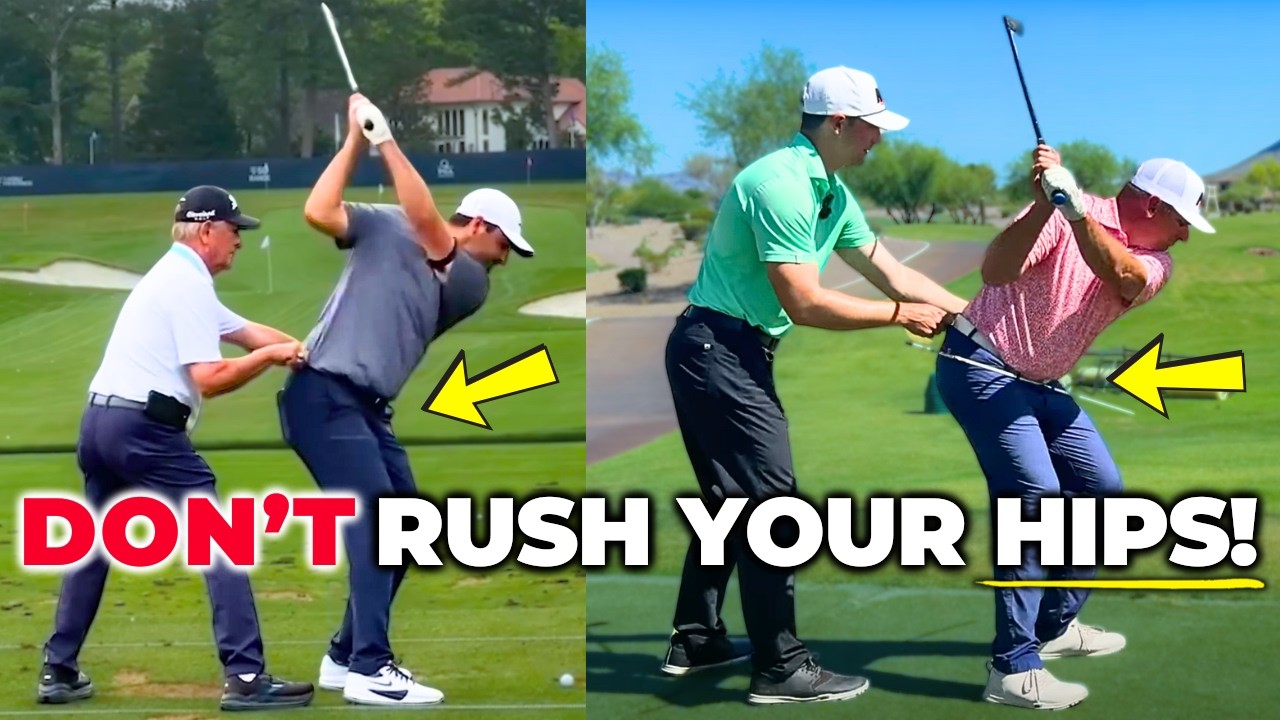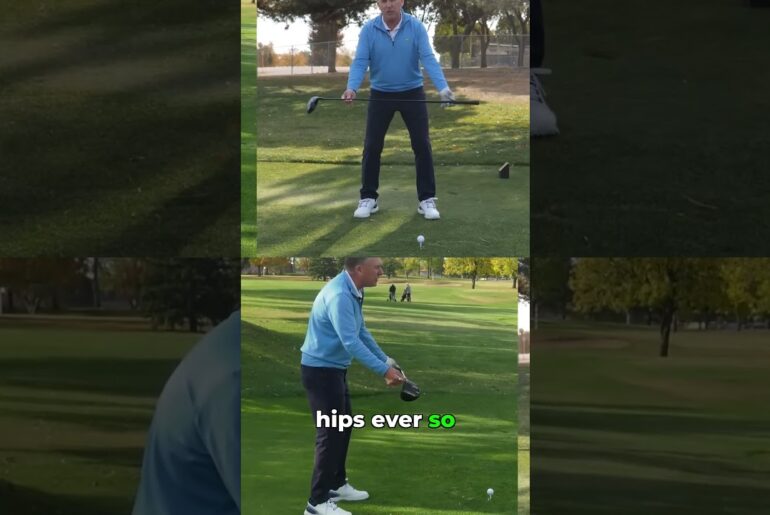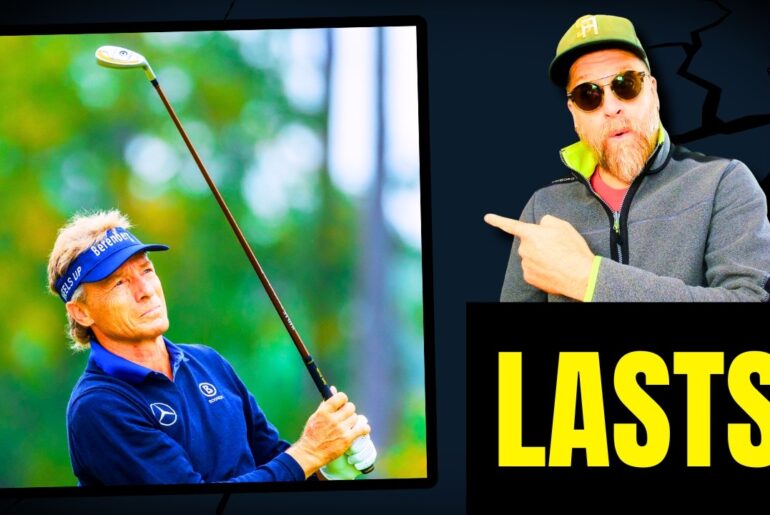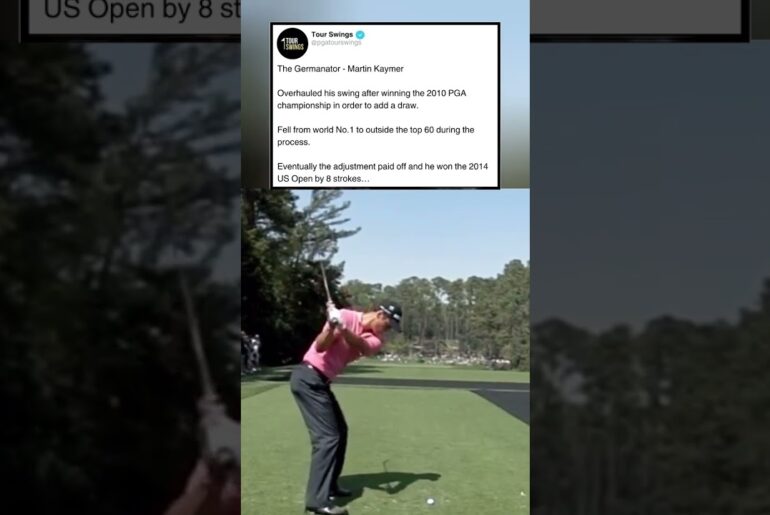What if there was a better way to get your hips open? Let’s look at the one move the pros are using to clear efficiently, safely, and powerfully! **Access my FREE 5 Keys to Rotation** https://milolinesgolf.com/5-keys-to-unlocking-a-rotational-golf-swing/
In this video, you’ll learn the key move you need to create effortless, efficient, pain free rotation without getting stuck, and compromising your path, low point, and club face angle. You’ll also see world #1 Scottie Scheffler working with his coach, Randy Smith on moving his hips properly in his golf swing, on his way to winning the 2025 PGA Championship.
In the past we’ve also heard from and shared Tiger Woods talking about his infamous “ole” move that gave him fits early in his career, and in this episode you will learn the dynamic, easier way to produce the rotation and clearing of the hips you desire, just like Scottie and Scheffler! We do hope you enjoy this episode. Henry and I look forward to your feedback.
SUBSCRIBE
https://youtube.com/@MiloLinesGolf
THE ATHLETE’S SWING :: ONLINE ACADEMY
BOOK A LESSON
GOLF SCHOOLS
MILO APPROVED TRAINING GEAR :: DISCOUNTS
WATCH THESE NEXT
FOLLOW MILO
Instagram: https://www.instagram.com/milolines_golf/
Facebook: https://www.facebook.com/milolinesgolf
Twitter: https://twitter.com/MiloLinesGolf
Don’t forget to LEAVE A COMMENT with any and all questions, video tip requests, and thoughts. We do our best to respond to every comment and sincerely appreciate your feedback!
Learn to Swing Like an Athlete™ with Milo Lines Golf! My channel and coaching team will provide you with lessons and tips to help you play better at this game and better tap into your inner athlete. Most of our content is filmed at the beautiful Superstition Mountain Golf & Country Club in Gold Canyon, Arizona.
#milolinesgolf #golf #golfswing
So many of you at home are really trying to get your hips open in the down swing and it’s really causing a lot of issues. So everyone, Milo Lines, Henry Fall back out here at beautiful Superstition Mountain. Thanks for joining us today. If you’re new to the channel, make sure you guys hit that subscribe button. We’d love to have you aboard. So Milo, we’re really working on today not twisting open that pelvis, doing it the right way. We’re going to be talking about number one in the world, too. Scotty Sheffller. So, I’m going to go I’ll stand back here and go really slow. So, I got the outside loops here. So, I’m just going to have a little back back. Yeah, Milo, we see that every single day. People trying to rip their pelvis open, twist it open, right? We all want to get open. Fire those hips. We got to fire those hips. Mhm. The thing is that’s really not what we want to be doing. It’s not the most efficient way to be getting open. And we want to get open at impact. You see it in the best players in the world. The best players in the world all have their hips some amount open, their chest some amount open at contact, but they’re not necessarily trying to fire everything their lower half as fast as they can. No. And we just posted a video recently and you guys probably saw the PJ championship with Scotty Shuffler. Yeah. Amazing win. amazing performance. But he was working with his coach that week, Randy Smith, a PGA professional like us. And Randy was grabbing his belt loops. I’m just going to go over here, Milo. Yep. His belt loops kind of from behind and helping Scotty feel that pattern in his pelvis. But was he really trying, do you think, trying to get Scotty to really open up and twist? No, I think I think he was trying to get Scotty to get away from the ball. We look throughout history with Scotty and we’ve seen him work on certain drills and exercises to bring about better space. One of those was he used an extension on the bottom of his club or into the butt end and he would basically make swings where he wouldn’t whack himself or stab himself. something we like to do as well. But it helps him feel like he’s got to be back and deliver the club kind of where he started so he’s got space. And then when I turn through, I got to get my rear end out of the way, which is one of the things we’ve been working on for you. Yes. You got to get it to stay back because Go ahead. And one thing Scotty does really, really well, even with some of his crazy footwork and sliding, is he backs up. He doesn’t move in. If we watch Scotty’s sliding, he does have a significant linear component. He goes more lateral than most, but he also goes, when we watch his feet, they both go away from the ball. Yeah. He’s not going toward that golf ball. So, let’s take a look at the unique action of Scotty Sheffler. And at the the root of his swing is really let’s let’s focus in on space and what he does. so well is create and maintain space in his golf swing. Whereas so many struggle with this pattern of invading the space. So what you’re going to notice is go up to the top, he does lower a little bit towards the end of his back swing. And now he’s really going to start to keep his depth. So you see that right glute push into that wall a little bit more. So he’s already starting to kind of back up and keep his depth. Obviously, his camera angle isn’t perfect, but at least gives you an idea that he is creating that space. He does some interesting stuff with his head and neck tilts there in transition, probably to allow him to come from the inside of the ball. Um, but you see his head backing away. You see his lead side backing away. And now you’re going to see the after effects of some of that with his footwork. that trail leg kind of crossing back behind him. Kind of a bowler look. Some baseball players actually work on this move as well. So, it’s uh an interesting pattern. Um but at the root of this golf swing, it’s all about creating that space. Something he’s talked about before. Point being, he is moving back where so many are moving into the ball and that is causing a lot of issues. So you can see even in his finish almost walking away towards the gallery. Pretty cool. So everybody before we get started walking you through the right way to do this I just want to touch on some of the wrong things that I see from players. So, what I really see, I see players winding up and then trying to fire their hips and keep their chest closed off as long as possible. So, it’s like their their chest is closed and their hips are firing. Oh, that hurts. Looks like an ouchie. Even in static slow motion, that literally pulls a lot of stuff in my body. Hurts. Well, and you guys probably noticed by now, Milo has a alignment stick through his belt loops, and we’ve positioned this pretty much right in the middle. So, both ends are a couple feet long. When you twist and contort your body like that, you get pretty stuck, too. This is kind of Tiger’s old Olay move that he struggled with. Yeah. It’s something I see a lot from kids. Yeah. You know, they’re generally rubber backs and so they can kind of get away with some of those things. Yep. where we adults who are a little stiffer, you know, probably not going to work so good. All right, Milo, we had switched sides there real quick. Just maintenance coming in. Um, but basically this X factor that we’re seeing people try to make, it’s putting an unnecessary torque on their body. It’s not really good for our body to be put in those positions in our opinion. Well, the thing is we all create some amount of X factor in the the winding phase of our golf swing. So, we’re winding up and we’re creating this this nice X factor. I just want to close that gap in my golf swing. I don’t want to feel like I’m making my hips separate from my upper body. That for me, that’s it’s painful, right? And it doesn’t make me go faster. As far as ripping the the hips open, too, Milo, if you show that from down the line, the other thing we tend to see is that this pelvis or you can look at Milo’s belt line gets very level or parallel to the ground. This is something I’ve struggled with in the past. So, we’re always trying to We want to make sure that we’re putting our pelvis a little bit more in an incline. It starts off on some amount of incline. Mhm. I like it to stay on plane, more or less. So, I wind. You can see it’s on on the same plane it started on and I unwind and it’s on the same plane on the other side. That’s symmetry for me. That’s simplicity. Creates space. when I wind fire. Right. Well, and you see it with a trail leg, too. It’s like everything’s pushing in. Yeah. Right. The the thought there for us anyways is that you’re now invading the space, as we say. You’re pushing in towards the golf ball. If you were to hit one, where you invade the space, I can’t hit one. Well, yeah. With a stick there, you’re not going to be able to hit one. I’ll miss. I might rip my pants off. But this is where you start to see someone early extend, push up out of the ground. Oh yeah. Their chest tends to back away and then you start getting some goofiness with the hands and arms to respond to all that. For sure. Let’s now dive into the right way, the way we want to see it. And the way she shuffler, how that exercise he was doing with coach Randy Smith was maybe helping Scotty with his ball striking. When I watched what Randy was doing, he was grabbing a hold of each belt loop. Yeah. And as Scotty wound up, he pulled the right hip away, so it created space. And then as he started down, it looked like he pulled both hips kind of this way. Yeah. Away. And then he turned the left one. So it was away, away, away more. I’ve heard that from you before. I’ve heard back, back, back. But now I’m hearing away, away, away. Yeah, I say back, back, back, away, away, away. I’ve actually grabbed a hold of lots of people’s belt loops and yeah, done that. Great exercise. It is. And what it creates for you is this awesome amount of space through here for you to be able to do whatever you want, right? If you have space and you’re a really talented athlete like Scotty is, obviously he’s got amazing hands. He’s good at everything. If he’s got space, he’s going to hit good shots. If he starts sliding forward and incur in invading the space now he’s taking away his ability to use his hands correctly and he’s just trying to put the club on the ball. Right. So let’s want to try one slow with that that feeling where I hold your loops back. Sure. Let’s do it. So I’m going to go I’ll stand back here and go really slow. So I got the outside loops here. So I’m just going to have a little back back. So I’ll be able to slow that down. You guys will see how much space Milo really had. miles. And the other thing is he got hip rotation. Oh yeah. But was that your focus? I didn’t even try to get hip rotation. I was just Well, I wasn’t trying to do anything. I let you pull me along. Yeah. And And I wasn’t like But I felt like I had even more space than I normally do. And I This is not something I t tend to struggle with. I move away. But I moved away a lot. Let’s do it again. So again, you just heard Milo say his focus wasn’t about twisting, opening, turning the hips. It was space. So, it was actually creating a little hinge if anything, right? That was pretty nice right there. Yeah. So, do you want to go on the golf course and just have me hold your loops all day? Uh, probably not. I probably shoot like a 65. Might. So, how can you work on this on your own at home if you don’t have a buddy to hold your belt loops? Because you probably would look really weird on the range doing that. Yeah, we But you could practice at home with like a chair. A chair. You could use a like a yoga ball, something that you can practice pushing back. Yep. So, the other exercise you could obviously do is put a belt loop or I’m sorry, a stick between or through your belt loops. Be a little careful with this one. We definitely recommend the cap side to be on the outside or the right side trail side. And it’s kind This is an exaggeration drill. If I wanted to hit golf balls with this, which I see lots of PJ Tour players doing it, by the way. Oh, yeah. It’s very common. And what they’re after is space. They’re trying to feel right hip out of the way. Right hip stays out of the way. Yeah. For me, it’s very easy. I can hit them as hard as I want with that drill. But in the beginning, I’ve actually seen people rip their pants off. So, maybe we should title a video that how to not rip your pants off. We’re not trying to keep our hips turned this way and fire our arms down in front. All we’re really trying to do is create the space away. Keep that space away and let that movement away. Y move our arms out in front of us. Now you have room. Now you’re using your middle, the engine. This is how you swing like an athlete and what we talk about so often. You want to show them one a little bit more at full speed with that stick? Sure. And you’re going to see how much room he has. And if you’re someone that struggles with getting your trail arm stuck, that can also help with that as well. You did it at full speed there, but we highly recommend just hitting little chip shots at first. Maybe show them that learning speed we’re after, Milo. Yeah, learning speed is like 30% effort, 40% effort. So, we’re we’re just moving this club through its full range of motion, but at a slow enough rate of speed where we can manage things. We’re actually controlling it. Cuz when we go full speed, it’s more of a reflex. You’re actually not really in control anymore. It’s just happening. Having played this sport now for 20 about 25 years, I can say to me one of the best feelings in the golf swing, the best feelings for my ball striking is space. When I can feel space and depth in my pelvis, it keeps my chest down and I can hit those quality strikes and after the ball starts online. Yeah, it it really is one of the best feelings you can have and most people never get it. So, I I I really hope you guys will take the what we’ve done here and apply it to your game, slow things down and work on this and that this concept that creates space for you also keeps you safe. So, bingo. I get players from all over the place wanting to be able to swing without pain. This is one of the very first things I I get to. We can swing safely, efficiently. It’s a lot more fun when it doesn’t hurt. So, there you go. Whether you’re the number one player in the world, Scotty Shuffler, or you’re a 25 handicap at home that’s struggling with low point control and pulls or slicing driver, work on this. Start here and you’ll develop a better ball striking pattern. Right. For sure. Well, hopefully you all enjoyed this and you learned something. Please hit that like and subscribe button if you did. And we look forward to having you come visit us at milolinesgolf.com where we can teach you to swing like an athlete with lots of personalized coaching just for you.








11 Comments
I find if I don't consciously try to turn my hips, I'm late and my hips are at best parallel to the target line at impact.
What's your go-to feel for your hips?
Access my FREE 5 Keys to Rotation: https://milolinesgolf.com/5-keys-to-unlocking-a-rotational-golf-swing/
I don't try to turn my hips, I just try to stick my left butt cheek back( right handed golfer).
Funny thing this is exactly what I do with my students and when they do it correctly all are surprised how easy the golf swing becomes
Great video, Milo. I'm one of those who tried the "olé" move a few years ago and did a number on my back.
I want to show you what type of instruction regarding hip movements was out there in the cybersphere only 10 years ago. This video I linked below shows Tyler Parsons demonstrating how to get more speed by "ripping" the hips on the foreswing. Even though Parsons features Kenny Perry on his channel and even has Perry do some of the recommended exercises, AIN'T NO WAY Kenny is going to do the career-ending firing of the hips. Go to minute-mark 6:05 to see these "rips". It's almost downright horrifying to see Parsons do these exercises.
https://www.youtube.com/watch?v=OoaV6XQkLyg
Instant classic. Finding "safe space" by a positive cue (eg, "away, away, away") rather than negative "don't" cues such as "no spinning hips open or early extension" leverages the ideal learning strategy. Really liked the why and wherefore on Scheffler's customized way to create space. Thanks so much for posting this.
Working on this myself … it’s gotta happen. What a difference. Can’t make a centripetal swing without this move.
Open your hips but don’t slide forward. Head behind
Hey guys! Good to see a new video. In movement circles what Randy was doing is called pattern assist. That works good if someone doesn’t know or remember what it feels like.
The more effective technique is called reflexive neuromuscular stabilization. To do this, you actually give pressure toward the inappropriate movement so that they have to figure out how to stabilize. The reason that this is better is twofold 1) wither pattern assist the don’t use the ground as much because you are assisting, and the movement usually comes at the wrong place/time. 2) when you “feed the dysfunction” I.e. push them in the non-optimal direction they have to figure out how to stabilize which will make them use the ground and learn the movement patter faster at a deeper level.
Ok, back to the video! Have a great day!
Alan
It's easy to stay out of the way, and create space, the hard part is synchronizing that with a low point after the ball.
Golf is def the gayest sport